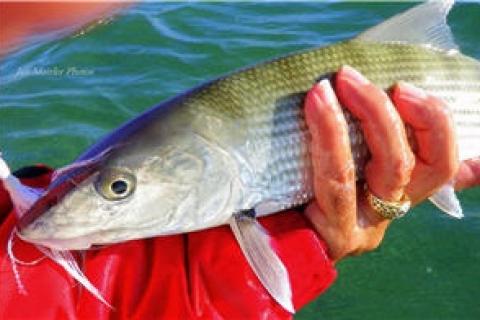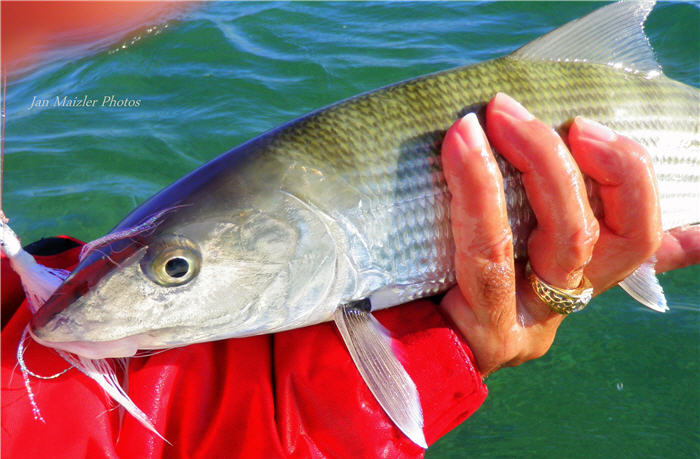
Fishing with the bucktail lure is basically some hairs tied to a jighead, which is the essence of simplicity itself. When the bucktail is white, it matches or mimics that vast majority of scaled baitfish around the world such as minnows, shiners, whitebait, sardines, mullet, and balao. Even the darker forage fish that live in the offshore weedlines have white bellies, which is exactly what gamefish like mahi are aiming for as they attack upwards in the water column.
 |
| Bonefish will grab a well-presented bucktail with vigor. This simple lure matches a variety of scaled baitfish and is especially effective in flats and shallows. |
While it’s often claimed this lure has no built-in action, thoughtful consideration will reveal this conjecture as only partially true. Fast-reeling a bucktail creates a streaking presentation that no feeding kings, mackeral, mahi, jacks, or barracuda can resist. Perhaps it’s more accurate to convey that a jigging or bouncing retrieve allows this marvelous lure to attract more of the same species of fish (as well as others) in a larger window of water, weather, and feeding conditions.
You’ll find bucktails are available in sizes ranging from 1/32 ounce to 5 ounces. Water depth, degree of current, size of the forage fish, and size of the target gamefish will determine the size of the bucktail. The basic rule is to keep the size of your bucktail as small as possible, which allows the smallest of your target species (as well as the largest) to partake of your irresistible and somewhat generous pseudo-meal.
The above factors as well as the actual action of the drop and retrieve of the jig in the water column determine your choice of jighead shape and style. The hookeye placement in your bucktail will determine its retrieve action as well as its retrieve in relation to the actual bottom, be it mud, grass, sand, reefs, or wrecks.
It will always pay to rig your bucktail with a loop knot to give it maximum action: this is regardless of whether you use a leader or not. As to fishing knot choice, either the uni-knot or Homer Rhode loop knot are fine.
Advice for Bucktailing the Flats and Shallows
- You’d be hard-pressed to find a more universal saltwater fishing lure for the flats and shallows than the white bucktail. Because of the brevity of the water column, choose smaller white bucktails from 1/8 ounce to 3/8 ounces. You’ll also find it prudent in your skinny water tactics to choose a flat skimmer head that will sink a tad more slowly than other jighead shapes. The flathead skimmer retrieves up and over grass clumps and beds most effectively as well.
- When you fish “deeply-forested” grassflats, be sure to use a skimmer bucktail jig that features a weed guard accessory. These monofilament devices project outward and ward off grass blades that might entangle your hook. They also bend quite easily and nicely to maximize your hookup as your quarry gobbles up your bucktail. BackBone lures come with a standard weed guard.
- When you’re casting on shallow flats, as soon as your bucktail lands, keep your rod high and begin retrieving. Make sure your retrieve style includes frequent and gentle upward sweeps of the rod, particularly when you’re blind casting to flat bottom. When you blind cast to structure such as potholes, pause your bucktail so it sinks into the depths of that hole briefly.
- My tackle choice for bucktailing the flats and shallows is spinning tackle featuring a nine-foot steelhead rod for the longest casts as well as a super-fast retrieve spinner loaded with eight-pound test mono line. Braided line is not needed as strikes are obvious, the fish are not far away, and braided line is too unforgiving on the soft mouth of seatrout.
For more tips on fishing the flats visit Travel Blog: Tips for the Traveling Flats Fisherman at Bass Pro Shops 1Source.
- 17038 views

